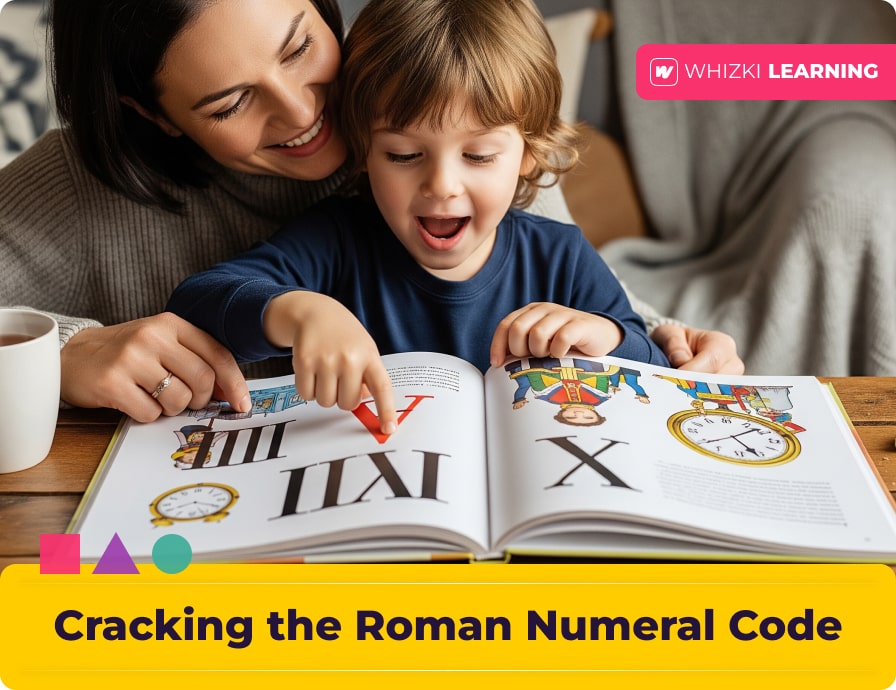You're reading a book with your little one, and you get to the chapter number: 'Chapter IV.' Your child points and asks, 'What are those letters for?' Or maybe you're looking at a grand old clock downtown and they wonder why it doesn't have 'normal' numbers. It’s a moment that can cause a slight panic in any parent. How do you explain this ancient, seemingly complicated system without causing confusion?
Here’s the secret: don't treat it like a math lesson. Treat it like you're letting them in on a secret code. A code used by ancient emperors, clockmakers, and even the creators of the Super Bowl! When you frame it as a fun puzzle, a child's natural curiosity takes over, and learning becomes a game.
The best learning doesn't feel like learning at all. It feels like discovery.- Sunny Hedge
This is your official 'spy briefing' for cracking the Roman numeral code. We’ll give you the simple keys and secret rules to become master codebreakers together. It’s easier than you think and a fantastic way to have some screen-free fun!

Meet Your 'Secret Agents': The 3 Key Players
To crack any code, you need to know the key players. In the world of Roman numerals, there are three main 'secret agents' that do most of the work for the numbers 1-10.
- Agent I: This is the easiest one! It looks like the number 1, and it means... one! (Like one finger).
- Agent V: This is our spy for the number five. (You can remember it because a 'V' shape looks a bit like an open hand with five fingers).
- Agent X: This is the master agent for ten. (Think of it as two 'V's'-two hands-put together, one on top of the other).
Almost every number you and your child will encounter at this age is just a clever combination of these three agents!
The Two 'Secret Rules' of the Code
Now for the fun part. There are only two simple rules your little spy needs to learn to be able to read almost any clock face or chapter number.
A simple, two-rule guide to help parents and children understand how Roman numerals are formed, focusing on the concepts of addition and subtraction.
Rule #1: The 'Team Up' Rule (Addition)
This is the most common rule. When smaller agents stand after a bigger agent, they just team up and add their powers together.
For example:
• VI = The big agent (V) comes first, so they team up! 5 + 1 = 6.
• VII = 5 + 1 + 1 = 7.
• VIII = 5 + 1 + 1 + 1 = 8.
Rule #2: The 'Sneaky Subtraction' Rule (The Tricky Part!)
This is the super-spy move that unlocks the most confusing codes. Sometimes, a smaller agent gets sneaky and stands before a bigger agent. This is a secret signal to subtract!
Decoding IV (The Number 4):
This is the one everyone asks about! When you see IV, the 'I' (1) is before the 'V' (5). This is the 'sneaky subtraction' signal! It means you take one away from five. So, 5 - 1 = 4. It’s just a clever, shorter way of writing IIII. You can see more about it on our Learning Hub page for IV.
Decoding IX (The Number 9):
It’s the same secret rule! When you see IX, the 'I' (1) is before the 'X' (10). It’s the signal to subtract! 10 - 1 = 9. It’s the secret code for nine!
Your 'Spy Training' Mission: Let's Get Hands-On!
The best way to learn a code is to use it. Here are a few fun, hands-on activities to make the learning stick.
- The Construction Yard: Get out some popsicle sticks or pretzel sticks. Call out a number and have your 'spy' build the Roman numeral version. This tactile practice is amazing for memory.
- The Real-World Code Hunt: Go on a scavenger hunt specifically for Roman numerals. Check the clock, look through the table of contents in a few big books, and see if you can find any on buildings in your town.
- The 'Logbook' Entry: After your spy has mastered the code, it's time to make it official in their 'logbook' (a Whizki workbook!). Open a math workbook for kindergarten to a page with regular numbers. Next to the big '4', have them proudly write 'IV'. This connects the new code to their existing knowledge and builds true, flexible number sense.

The Best Gear for Any Mission
Every spy needs great gear. At Whizki, we believe the best tools are the ones that are fun, engaging, and screen-free. While your little spy is cracking the code of Roman numerals, our kindergarten workbooks are the perfect place to build their foundational understanding of what those numbers actually mean. They are the perfect 'logbook' for every learning adventure.






